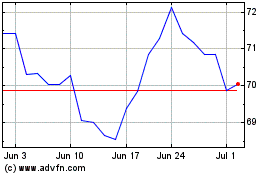UPDATE: FDIC Reviews Insurer Disclosures On Retained-Asset Accounts
August 12 2010 - 4:34PM
Dow Jones News
Sheila Bair, the head of the Federal Deposit Insurance Corp.,
said her agency is reviewing the disclosures life insurers send to
beneficiaries to determine if they mislead consumers about whether
her agency backs their accounts.
Bair cited "potential confusion" by consumers as a reason for
the review of the so-called retained-asset accounts. When a policy
holder dies, some insurers put beneficiaries' funds into the
interest-bearing accounts and send them checkbooks to allow them to
drawn down the funds instead of sending a single check for the full
amount of their payout.
At least some insurers have both their company's name and the
name of a bank that acts as an intermediary on their checks.
"Public understanding of FDIC insurance and when and how our
guarantee applies is of the highest importance to us," Bair wrote
in a letter to Therese Vaughan, the chief executive of the National
Association of Insurance Commissioners. The letter, dated Aug. 5,
was posted on the FDIC website.
Disclosures reviewed by Dow Jones show the two largest life
insurers, MetLife Inc. (MET) and Prudential Financial Inc. (PRU),
currently tell beneficiaries their accounts are not FDIC-insured.
Prudential includes the information in a letter to beneficiaries,
while MetLife includes it in the first paragraph of its "customer
agreement" and in a brochure it sends to beneficiaries.
"Based on our Legal Counsel's initial review of sample
documentation from an insurance company to a beneficiary, we
believe that consumers may mistakenly conclude that the RAAs are
products offered by insured depository institutions and, further,
that the RAAs are FDIC-insured accounts," Bair's letter said.
Instead of the $250,000 guarantee that backs FDIC-insured bank
accounts, funds in insurers' retained-asset accounts are backed by
state insurance guaranty funds. They typically offer protection of
$300,000 or more.
Some critics of the accounts have questioned whether the state
guaranty funds would back the accounts if an insurer failed,
suggesting they could be considered separate from the insurer's
other obligations to policyholders.
But Peter Gallanis, the president of the National Organization
of Life and Health Insurance Guaranty Associations, said that
assertion was false. State guaranty funds, he said, have in fact
paid out on the accounts in the past.
He cited the failure of several companies run by financier
Martin Frankel that were taken over by state regulators in the late
1990s as an example. Frankel was sentenced to more than 16 years in
prison in 2004 after pleading guilty to 24 counts of fraud and
racketeering.
"They were treated just like a death benefit," Gallanis said of
the retained-asset accounts at insurance companies where Frankel
played a role. "For our record-keeping purposes, RAAs are
categorized as death benefit payments. There's no difference in our
eyes."
Still, the NAIC has announced its own review of what and how
insurers tell beneficiaries about the accounts, and plans a meeting
of a working group to examine the topic at the organization's
quarterly meeting in Seattle this weekend.
New York Attorney General Andrew Cuomo is among the officials
who have said they are examining the accounts. He announced a
"major fraud investigation" last month, and said insurers are
pocketing "secret profits" by paying less in interest than they
make by investing the funds.
Insurers targeted by Cuomo, including MetLife and Prudential,
have said the accounts provide a valuable service to grieving
beneficiaries who need time before making decisions about what to
do with their payouts. The practice of offering the accounts dates
back more than two decades.
Edolphus Towns (D-N.Y.) also said this week that the House
Oversight and Government Reform Committee that he chairs is
investigating the payouts after he learned that Prudential does not
automatically deliver a lump-sum check to beneficiaries of deceased
soldiers. Prudential runs the government's life insurance programs
for soldiers and veterans.
Seperately, the head of the National Conference of Insurance
Legislators on Thursday proposed that states adopt a rule requiring
insurers to have beneficiaries opt in to the accounts instead of
making them the default option.
Insurers typically pay rates on the retained-asset accounts akin
to money-market accounts. Some guarantee minimums either when the
policies are sold or when they're redeemed, meaning some companies
currently have customers earning 3% or more, at a time when
money-markets are yielding far less.
-By Erik Holm, Dow Jones Newswires; 212-416-2892;
erik.holm@dowjones.com
MetLife (NYSE:MET)
Historical Stock Chart
From Jun 2024 to Jul 2024

MetLife (NYSE:MET)
Historical Stock Chart
From Jul 2023 to Jul 2024
